 The Ones that Got Away (cont’d)
The Ones that Got Away (cont’d)
… Picking up where I left off in my previous post, no one in LIFE magazine’s photo department or editorial hierarchy would have learned of the “Fortitude South” deception, to which only a few in the military were privy — the top-secret effort by Supreme Headquarters Allied Expeditionary Forces (SHAEF) to persuade the German high command in Berlin that the Normandy attack was merely a feint, with the real invasion yet to come at Pas de Calais. That disinformation campaign surely led to much unexplained and thus seemingly arbitrary military censorship of D-Day press coverage, including Capa’s.
However, the existence of the elaborate SHAEF military censorship system operative on D-Day, which Charles Herrick has described at length, was unquestionably well-known to both Morris and Capa. (Morris sketches his interactions with military censors several times in his 1997 memoir, Get the Picture, and Capa had accidentally triggered a major censorship crisis in 1942, detailed here by Herrick.) Just as certainly, its existence was known to and understood in general terms by LIFE picture editor Wilson Hicks back at that magazine’s New York headquarters. So LIFE‘s photo and editorial staff had long since accepted the rigorous military censorship process through which all press material necessarily passed — authorized to delete anything problematic from or impound entirely any such material without explanation, with those decisions not subject to appeal.
 In this case, what remains of Capa’s work on the D-Day story, in the form of negatives, contact sheets, and caption notes held in the Capa Archive at the International Center of Photography, indicates that the censors held back at least half of the negatives on the rolls in that collection. (Click here for my analysis of those holdings.) Consequently, there’s no longer any reason to think that Capa had any need to shore up his status at LIFE by claiming that additional film got destroyed in the darkroom. Nor did Morris have any in-house self-protective need to claim that Capa produced more publishable images than he actually did, much less any motive to protect his friend Capa’s reputation by fabricating an explanation for missing film. To the contrary, had LIFE‘s New York office complained about any shortage of Capa imagery, both Capa and Morris could simply have blamed the censors.
In this case, what remains of Capa’s work on the D-Day story, in the form of negatives, contact sheets, and caption notes held in the Capa Archive at the International Center of Photography, indicates that the censors held back at least half of the negatives on the rolls in that collection. (Click here for my analysis of those holdings.) Consequently, there’s no longer any reason to think that Capa had any need to shore up his status at LIFE by claiming that additional film got destroyed in the darkroom. Nor did Morris have any in-house self-protective need to claim that Capa produced more publishable images than he actually did, much less any motive to protect his friend Capa’s reputation by fabricating an explanation for missing film. To the contrary, had LIFE‘s New York office complained about any shortage of Capa imagery, both Capa and Morris could simply have blamed the censors.
Subsequently, no public comment on Capa’s images, or LIFE‘s publication thereof, required any public rationalization re lost/destroyed film. So censorship by SHAEF provided a sufficient, ready-made internal excuse at LIFE for the absence of any particular type of image or coverage of any specific subject, as well as for the overall amount of imagery surviving SHAEF’s redaction. Which brings us back to where we began — the origins of the myth.
•
The very first version of the Capa D-Day myth appeared in print in September 1944. In October 2015, in a much earlier post in this series, I wrote,
“As previously noted, Capa himself almost immediately began spreading his tale of a greatly exaggerated timeline and an account of a darkroom disaster — in conversation with LIFE correspondent Charles Christian Wertenbaker (which Wertenbaker paraphrases in his September 1944 quickie book Invasion!), and in a private letter to his younger brother Cornell, who relayed it to John McNamara for use in his young-adult book Extra! U.S. War Correspondents in Action, published in early 1945. But at first Capa disseminated it only anecdotally, not going on the record with it in his own words.”
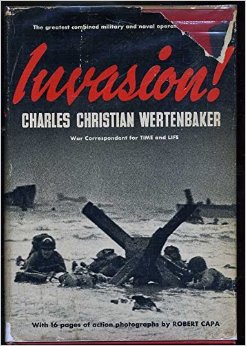
Charles Wertenbaker, “Invasion!” (1944), cover
Wertenbaker based the passage in his book involving Capa on an interview he conducted with Capa on June 9, just three days after the landing. Most of it Wertenbaker presents in presumably direct quotation from Capa, and in it one can see the photojournalist already rehearsing the version he would later put on paper for his 1947 memoir Slightly Out of Focus. (Notably, he does not claim therein to have gone in with the first wave, presumably because Wertenbaker, who also covered the landing, would have known that no journalists accompanied the first wave. But Capa does imply that he went in with the second wave.)
After the long, continuous quote from Capa about his experiences on D-Day, Wertenbaker adds this, in his own words:
“Bob Capa had taken 79 pictures of the fighting on the beach. They were the only complete photographic record of the worst hours of the invasion. A careless dark-room assistant ruined all but seven of them.” (P. 44.)
On June 9, of course, neither Capa nor Wertenbaker could have had any idea what had become of Capa’s films; LIFE‘s D-Day edition, datelined June 19, would not hit the newsstands in the States until June 12, and on June 9 what Morris has sent them was still en route to the New York office.
So Wertenbaker’s addendum re the supposed darkroom disaster postdates his interview with Capa. Only two possible sources for it propose themselves: Robert Capa and John Morris. Capa had already achieved celebrity status, certainly in war-correspondent circles; he and Wertenbaker would have treated each other as equals, whereas Wertenbaker — by then a senior correspondent and the magazine’s foreign editor — wouldn’t have had dealings with an underling like Morris in the normal course of events. So odds are that he heard the story of the darkroom accident directly from Capa.
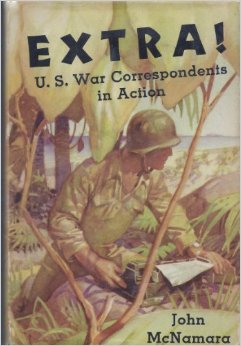
John McNamara, “Extra!” (1945), cover
The next version of the darkroom-accident fabulation to go public appears in the McNamara book mentioned above. In this case, we know that it came to that author from Capa, via his younger brother Cornell, as indicated in the book’s credits. (The Capa Archive at the International Center of Photography holds a letter from Robert to Cornell, sent soon after D-Day, that claims his best images got destroyed in the darkroom.)
After that, this fiction shows up next at the end of the D-Day chapter of Capa’s 1947 memoir, Slightly Out of Focus.
So far as I have managed to discover, it does not appear in anything involving John Morris until much later.
It would seem, then, that Morris played no active role in originating the narrative of the darkroom accident. Rather, riding Capa’s coattails in relation to the D-Day myth, he perforce got roped into endorsing and elaborating it (though not at all unwillingly) once the myth started to embed itself in cultural consciousness, starting in the early 1960s.
•
It surprises me to find myself writing that, as it likely surprises those who have followed this investigation closely over time.
Early on, I came to the conclusion that Morris had concocted this tall tale spontaneously on the night of June 7 or the early morning of June 8, as an in-house way of explaining to Wilson Hicks in New York why Capa (and he) were supplying so few images of the actual landing. In which event it was both protective of his friend Capa and self-protective — understandable, even if not exactly admirable. But never intended for publication.
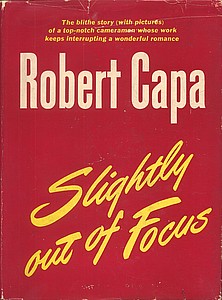
Robert Capa, “Slightly Out of Focus” (1947), cover.
I reasoned further that because its specifics are so technically implausible — b&w film and drying cabinets simply don’t work that way — this scenario could only have come from the imagination of someone proudly ignorant of elementary darkroom procedures, like Morris.
Based on that, I figured finally that Capa eventually decided to make that story public in his memoir on the expectation that the average reader (and moviegoer, if he succeeded in selling this to Hollywood) would neither know nor care that this extremely visual moment was highly unlikely. So that Morris then got stuck with it thereafter — hoist on his own petard, as it were.
Knowing now that Capa and Morris had an unimpeachable excuse — the SHAEF censorship system — at hand for the paucity of Capa’ss coverage, I see no reason for Morris to invent some far-fetched alibi to explain what he sent to LIFE in New York from Capa. So I’m forced to conclude that Capa himself made the darkroom-disaster story up from whole cloth, on his own, weeks after the fact, trying out several versions in public before finally settling on the most cinematic (if also most improbable) variant for his memoir-cum-film-treatment.
This still leaves us with a question: Why did Capa concoct the tall tale of destruction of his negatives in a darkroom accident, and why did John Morris go along with it?
•
To begin with, the mere fact that Capa and Morris had to submit their efforts to a mysterious external oversight structure that left them powerless — SHAEF’s Ministry of Information — impeaches their self-presentations as autonomous actors in the D-Day drama. Thus it represents one good reason why neither mentions the SHAEF filter through which Capa’s negatives and caption sheets had to pass before reaching Morris’s hands and thereby entering LIFE‘s editorial pipeline.
For Capa, whose planned memoir required a dramatic D-Day chapter as its centerpiece, the plain facts of his actual D-Day experience would not suffice. Morris had an equally important reason to go along with Capa’s fiction: The truth underscores how little power and authority he had in his menial role as assistant picture editor in LIFE‘s London office, the minimal control he could exert in that position.
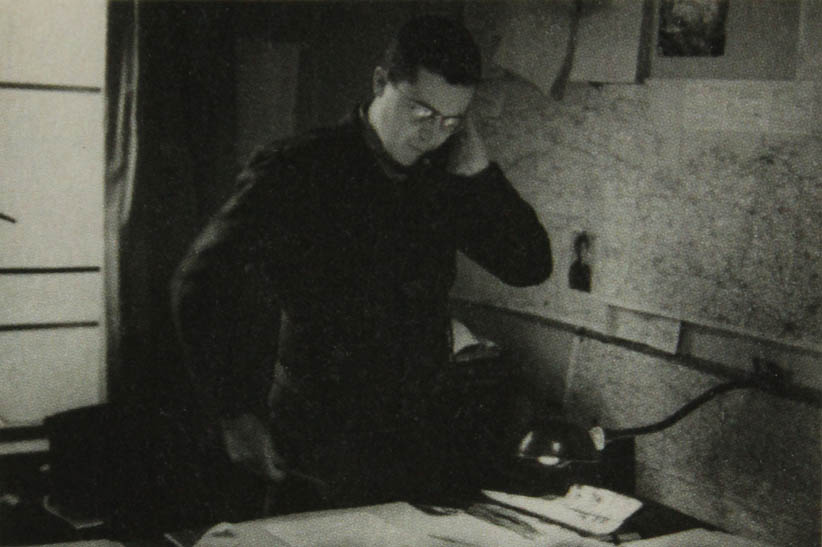
John Morris, LIFE office, London, 1944. Photo: David Scherman.
• He could not hire or fire any staff photographers or freelancers. He had not hired and, most likely, could not have fired darkroom chief H. C. “Braddy” Bradshaw. I doubt that he could even have fired any of the teenage “darkroom lads” hired and trained by Bradshaw. All such decisions were well above his pay grade.
• He could propose to the staff photographers ideas for stories, which they were free to accept or reject, and vett and pass along any proposals that came in from freelancers, but final approval of any proposal, as well as of any finished assignment, would come from above — Wilson Hicks, back in New York. Meanwhile, the staff photographers could propose and arrange feature stories without consulting him, as Bob Landry did.
• For the magazine’s D-Day coverage Morris had no say over the assignments of the staffers and Capa, who, in consultation with SHAEF, decided to which units they’d attach themselves for the invasion.
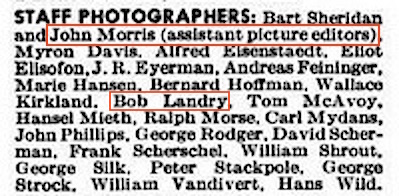
LIFE masthead, John Morris and Bob Landry, June 19, 1944
• Listed among the magazine’s “staff photographers” on the masthead, he had — the evidence suggests — no executive authority whatsoever.
• SHAEF censors would do the first edit of their results, and Morris would have no right of appeal; indeed, he would never even lay eyes on what the censors held back. He could only select the best images from whatever they let through, caption those for the press pool and the New York office, and meet the deadline for the flight to the States.
• Yet, before Morris turned his materials over to the courier on the morning of June 8, he had to get them approved a second time by the censors — a process he does describe, albeit briefly and dismissively, in Get the Picture.
• In short, he was little more than a gofer, a glorified office boy, still running errands for Hicks, only now from across the Atlantic. In the parlance of the times, he was low man on the totem pole.
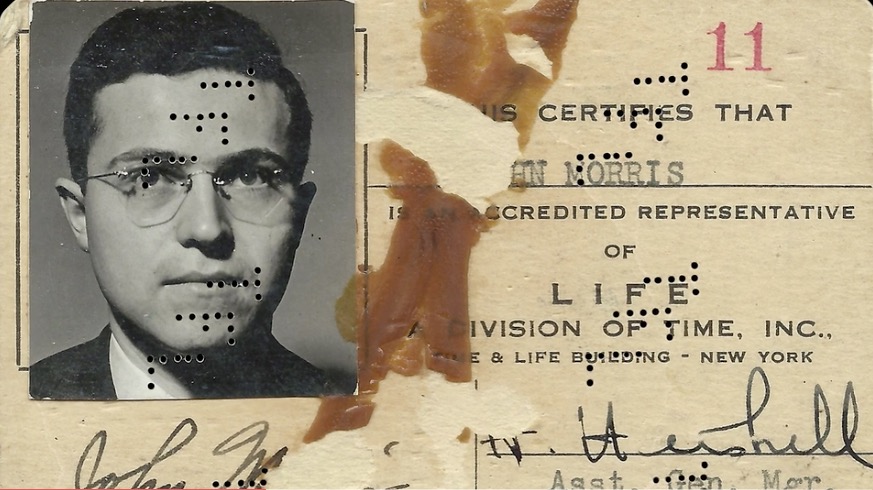
John Morris, LIFE press credential, ca. 1944
• Hardly surprising that in all of his accounts over the years he omitted any mention of SHAEF’s initial edit of Capa’s D-Day take, since it both gives the lie to the melted-emulsion fable and demonstrates how little editorial autonomy he actually exercised in that situation. Small wonder that he welcomed the spotlight that Capa’s public initiation of the darkroom-disaster myth shone on him, offering as it did an unexpected starring role in the drama to one otherwise relegated to the ranks of the bit players.
•
In hindsight, I can see where I went wrong when I began my effort to sort out fact from fiction in the various accounts of Capa’s D-Day experiences and the fate of his negatives.
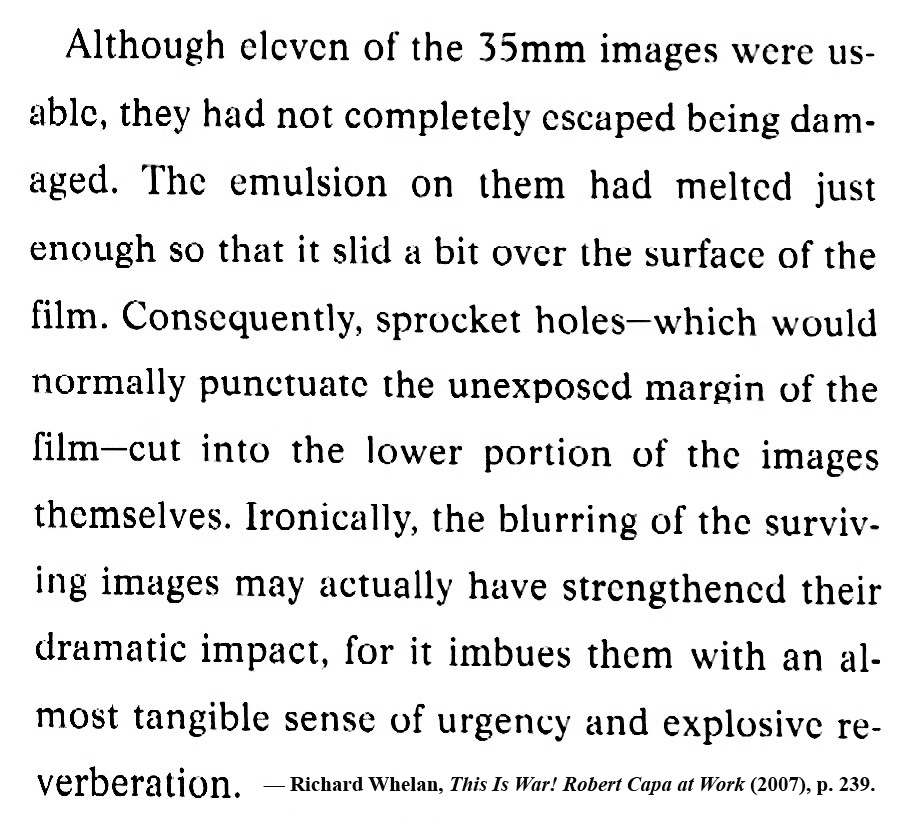
Richard Whelan on Robert Capa’s D-Day negatives, “This Is War!” (2007), p. 239.
First, I let myself get seduced by narrative — to whose temptations I confess myself no less vulnerable than most. In place of the established myth, with its enticing melodrama, I supplied an alternative tale with its own attractions, an intricate skein of personal and interpersonal motivations: fear, failure, guilt, self-protection, camaraderie, white lies. No less rewarding, I’d like to think, just in a different way. But also no less obfuscating.
Second (and definitely related to the first), the undeniably nice guy who resides beneath this crusty, critical exterior wanted some reason for the myth’s creation and perpetuation with which I could empathize — something that, though not ennobling, would humanize the protagonists without diminishing them. Not big events, but large emotions, complex motives.
Instead, I end up — and you along with me, dear reader — with something nowhere near tragic, merely sordid and bathetic: Constrained by logistics, Capa did the bare minimum that the job required, then exaggerated his D-Day experiences and made up the darkroom-disaster story so that he could maintain his professional reputation and flog his memoir to Tinseltown: a clear-cut case of stolen valor. And Morris, who had no significant editorial role in the making of LIFE‘s D-Day feature but merely packaged what he received from SHAEF, went along with Capa’s histrionic version because his professional reputation depended mostly on his association with Capa, especially on that particular shared historical moment in both their lives, and the fish story that Capa concocted and loosed on the world turned this 27-year-old desk jockey from a marginal character into a central one.
All logistical and pragmatic. Not much of a story. Hardly worth the telling, much less the retelling.
How disappointing.
•
And one more letdown. In Slightly Out of Focus Capa wrote,
“[Before leaving London for the invasion] I bought an English Army raincoat at Burberrys, and a silver pocket flask at Dunhill’s. …
“At 2:00 A.M. the ship’s loudspeaker broke up our poker game. We placed our money in waterproof money belts and were brutally reminded that the Thing was imminent.
“They fixed a gas mask, an inflatable lifebelt, a shovel, and some other gadgets around me, and I placed my very expensive Burberry raincoat over my arm. I was the most elegant invader of them all. …
“I was going in very elegant with my raincoat on my left hand. I had a feeling I would not need that raincoat. I let go of it and it floated away and I hid behind some tanks that were firing on the beach. …”
This is pure bullshit. Capa believed in and advocated a policy of never carrying photo gear or other equipment that you would not use. He intended to reboard the Chase as soon as possible, so as to return to England that day with his film. He would certainly have no need of a high-end raincoat that morning.
So he took no pack or other items with him save for his cameras and film, leaving all the rest of his kit on his bunk back on the Chase. The film clips by USCG cinematographer David T. Ruley made on the return trip to the Chase from Omaha Beach show him unencumbered by anything other than his cameras and leather shoulder bag. He wrote this vignette — like the one about the melting emulsions on his films, another resonant but fictional visual image — with his plan to sell the book to Hollywood in mind.
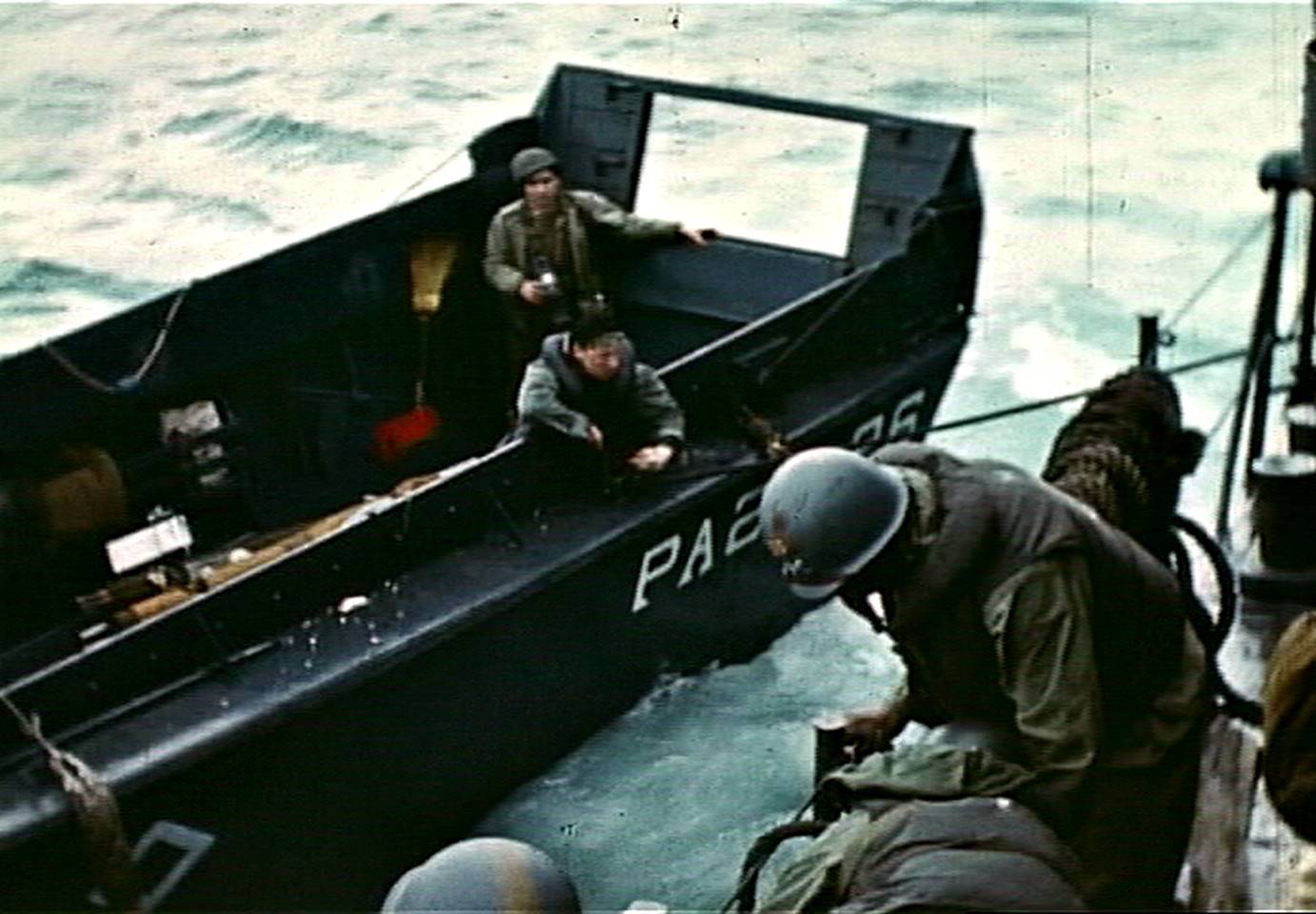
Fig. 12: Robert Capa, center rear, aboard LCVP from USS Samuel Chase, photographing transfer of casualty, D-Day, frame from film by David T. Ruley
(Part 1 I 2)
•
(For an index of links to all posts in this series, click here.)
•
Special offer: If you want me to either continue pursuing a particular subject or give you a break and (for one post) write on a topic — my choice — other than the current main story, make a donation of $50 via the PayPal widget below, indicating your preference in a note accompanying your donation. I’ll credit you as that new post’s sponsor, and link to a website of your choosing.
 Include a note with your snail-mail address (or email it to me separately) and I’ll include three (3!) copies of The Silent Strength of Liu Xia, the catalog of the 2012-13 touring exhibition of photos by the dissident Chinese photographer, artist, and poet, who, after eight years of extralegal house arrest in Beijing, finally got released and expatriated to Germany in 2018. The first-ever publication of her photographic work, it includes all 26 images in the exhibition, plus another 14 from the same series, along with essays by Guy Sorman, Andrew Nathan, and Cui Weiping, professor at the Beijing Film Academy. Keep one for yourself, share the others with friends.
Include a note with your snail-mail address (or email it to me separately) and I’ll include three (3!) copies of The Silent Strength of Liu Xia, the catalog of the 2012-13 touring exhibition of photos by the dissident Chinese photographer, artist, and poet, who, after eight years of extralegal house arrest in Beijing, finally got released and expatriated to Germany in 2018. The first-ever publication of her photographic work, it includes all 26 images in the exhibition, plus another 14 from the same series, along with essays by Guy Sorman, Andrew Nathan, and Cui Weiping, professor at the Beijing Film Academy. Keep one for yourself, share the others with friends.






Not sure if this will be useful to you but here goes: My father, Lenny Doyle, served in the 1st Engineer Combat Battalion with the 1st Infantry Division and made the Omaha Beach landing on D-Day (he passed away in 1993). He told us that he had spoken with Capa prior to the landing, not sure if it was on the Samuel Chase or in the landing craft. I recently found this article on HistoryNet which names my father as a radio operator who hit the beach with the author (William Kays). In addition to the photos in Kays’ article, I am quite certain that my dad is one of the soldiers in one of Capa’s photos, the one that shows several soldiers lying on the sand behind a hedgehog.
https://www.historynet.com/i-stormed-ashore-with-robert-capa-on-d-day.htm
Military historian Charles Herrick effectively disproved the claims of William Kays in this 2019 post here at my blog.
Since Capa rode in not with the engineers in the second wave, but with Col. George Taylor’s staff in the thirteenth wave, your father could not have spoken with him en route to Easy Red. If they did encounter each other, it would have happened aboard the Chase during the crossing.
If your father served as an engineer, it’s certainly possible that he appears in Capa’s images of the engineers at work on Easy Red. Unfortunately, the images aren’t quite sharp enough to verify that beyond any doubt.
For what it’s worth, in his posthumously published book This Is War! Robert Capa at Work (2007) Richard Whelan, Capa’s official biographer, identifies the only visible face among those engineers as one William P. Buehl. (He also identifies “The Face in the Surf” as Huston “Hu” Riley — incorrectly, it turns out.)
Nice article. I do agree on the fact that the story of the ‘lost’ images in BS, I don’t agree with you with why and what really happened.
I have one question for you, since you studied this way more than I could even possibly do, I think you could help me out understand in a bit more…
If Capa really wanted to stay on Omaha just the bare minimum to do his job, why did he go back to Omaha the next day to rejoin the troops and stay with them until the end?
If as you say he just wanted the cover the bare minimum and then get the hell out he would have be back in London the very same day. Which he didn’t.
Thank you for your precious time.
The fact that you “don’t agree with [me] with why and what really happened,” without offering either contrary evidence or even any alternate explanation of the established facts, makes your disagreement meaningless.
The question isn’t what Capa “wanted.” On the morning of June 6 he simply faced a specific, intractable deadline that forced certain decisions on him.
As I wrote, he might well have stayed longer on Omaha Beach if the landing had taken place the previous day, as originally planned.
He himself didn’t need to “be back in London the very same day,” or even be back in London at all. But his films needed to get to LIFE‘s London office by the evening of June 7. If that didn’t happen he would have effectively blown the assignment. So the films needed to get to the SHAEF couriers in Portsmouth as early as possible the day after the June 6 landing, in order to get to LIFE later that day.
The timing of Capa’s arrival on Easy Red (over which he had no control) left him with very little time to make some pictures and catch a ride on a ship heading back to the USS Samuel Chase (scheduled to leave at noon), which would take him and his films back to the English coast, putting him there sometime on the 7th.
It’s not clear whether he had the option of turning his film over to a courier on Omaha Beach and staying with the invading troops. (This account suggests that he didn’t.) In the event, he chose, probably wisely, to take those films back himself so as to ensure their safe delivery to the military couriers in England, who would in turn get them to LIFE magazine in London and put them through the SHAEF censorship system.
Capa returned to Normandy as soon as he could because he had a contract with LIFE magazine to cover not just the D-Day landing itself but the invasion, an ongoing military operation. Had the invasion failed, he would not have returned. But by the time he landed in Portsmouth, on the afternoon of June 7, he had learned that the Allies had established beachheads on the Normandy coast and had begun moving inland. So he decided to return and follow them, to continue his assignment.
Hope this clears up any confusion.
I wanted to comment on your excellent analysis as we approach the 80th anniversary of D-Day. Apologies if you have covered this theory in your writing, but I wonder if there is a second reason for the ruined film story: a reason of reputational damage control.
It’s no coincidence that many of the pictures selected by the censors are blurry – as you point out it’s impossible to see any details on the images, hence them being cleared by the censor. But it leaves Capa with a problem – why are these the only pictures of his being published? Any photographer or photo editor would never select these images – they would be crossed out on the contact sheet as blurry outtakes. Yet, these are the photos being published. Capa was, above all, a proud man, proud of his reputation, and proud of his ability to get clear images under fire.
So what better way to explain this disparity than to say “they were ruined in a darkroom mishap”? Then he can put up his hands and say “not my fault! I gave them hundreds of crisp images but these were the only ones they could salvage”.
It makes sense, no?
I would agree that with two exceptions — the blurred first image of the backs of the off-boarding troops, and “The Face in the Surf” — Capa’s Omaha Beach photos qualify as unexceptional and indeed mediocre.
Somewhere along the line I did ponder the question you raise. (Can’t locate it readily.) Ultimately I set it aside, for the following reasons:
(a) LIFE found them suitable for publication and sufficient;
(b) Wilson Hicks himself complimented Capa for them and, on the basis of this freelance assignment, offered him a staff position;
(c) there’s no evidence suggesting that, at the time, anyone else found Capa’s D-Day coverage wanting; and
(d) no one thereafter has suggested that they were anything other than “magnificent” (until our project came along).
Therefore Capa faced no external pressure to rationalize either the quantity or the quality of his D-Day coverage. His reputation did not in any way suffer from it, and he needed no excuses for it.
Did he feel guilty for having done a less than superior job, project an accusation of same, and believe himself compelled to present a lame explanation? That doesn’t sound like Capa to me — more like someone suffering from impostor syndrome. In any case, I try my best to avoid amateur psychoanalysis.
Especially when Occam’s razor serves the occasion, as I propose in this series of posts. As we now know, Capa had a perfect excuse ready to go: I made dozens of great images on Easy Red, and the censors held back all but ten. By the time he published Slightly Out of Focus in 1947 he could have said that without violating any protocols. And indeed it would have made a visual moment no less cinematic than the fictional melting emulsion, and certainly more plausible.
Thank you for that explanation – it makes a great deal of sense. I suppose I was framing it more as a case of bruised ego than “guilt” or “impostor syndrome”. But my knowledge of Capa as an individual is lacking.
I had one other question, if you don’t mind: the “15 year old darkroom lad” sometimes identified as one Denis Banks. Did such a person exist? And if so what was his reaction to the story? One supposes that surely blaming a real, named person (a 15 year old boy, no less!) and repeating the story for decades would be extraordinarily mean. Has your research shed any light on this?
Yes, there was a “darkroom lad” named Denis Banks (sometimes misspelled as Dennis) present in the LIFE facility on D-Day. Morris even claimed to have met him again at LIFE‘s London office some years after the war, when he returned to London in 1953. Others also remember him, and his name appears in at least one postwar in-house newsletter.
Doris Landry Millichip, LIFE staff photographer Bob Landry’s widow, tried to track him down for us in England, but the trail had gone cold.
Banks went unnamed in Capa’s account, and in all early Morris accounts. He only got named by Morris after the rumor began to circulate that photojournalist Larry Burrows was the one who had supposedly “ruined” Capa’s film. Presumably, having helped concoct and disseminate the melted-emulsion story, Morris felt obligated to exculpate Burrows, and pinned the blame on Banks. (Burrows was also there on D-Day plus one, but in the role of “tea boy” — errand boy — rather than darkroom grunt.)
We’ve found no evidence that Banks ever became aware of Morris using him as a scapegoat for the entirely fictional loss of Capa’s D-Day films. That began sometime in the late 1970s, by which time Banks might well have retired or left the field. Nor do we have any assurance that Banks had even learned of the mythical darkroom disaster, much less Morris’s implicating him in it. So casting him as the culprit, however mean-spirited (and selfish) it seems, may have had no impact on him.
See our latest installment for more information on LIFE‘s D-Day procedures and protocols.
P.S. If you’re in a position to help us track down Denis Banks and fill in his backstory — via a search though London-area obituaries, employment and post-office records, phone directories, etc. — I’ll gladly publish a Guest Post by you here detailing the results. That would tie up at least one loose end.